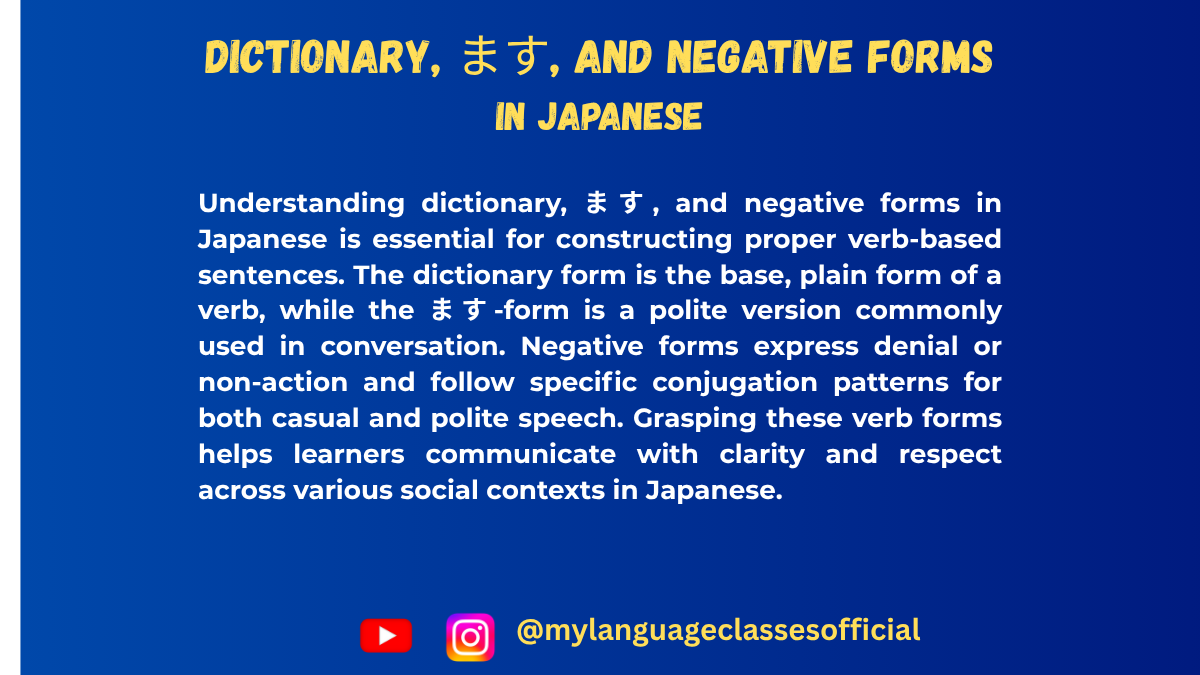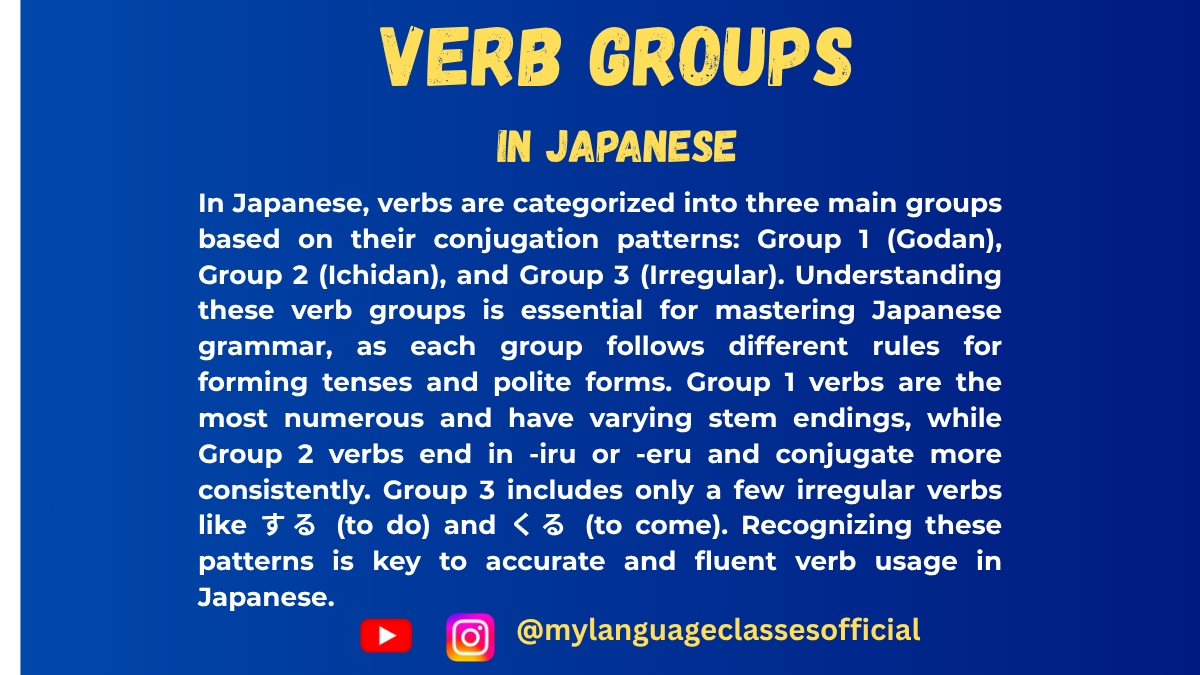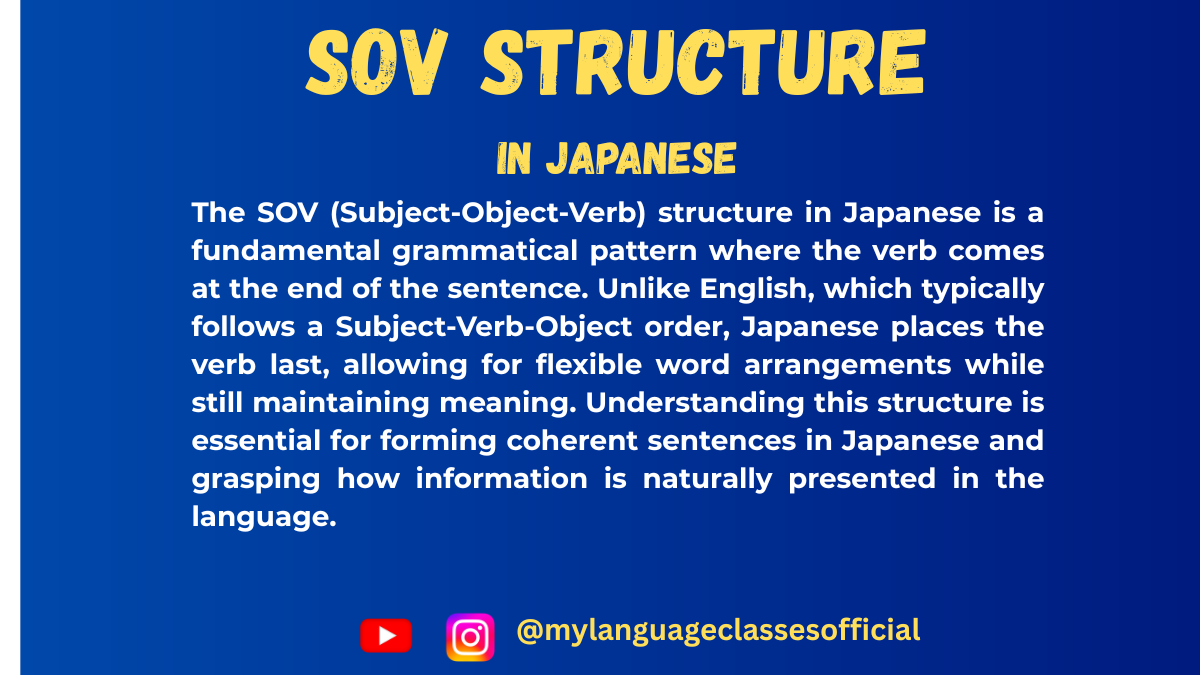Your cart is currently empty!
Tag: Japanese verbs
-

How to Use Verb Forms (Dictionary, ます,ません) in Japanese | My Language Classes
Japanese Verb Conjugation: Dictionary, ます, and ません form
When learning Japanese, verbs are a foundational aspect of the language, and understanding how to conjugate them correctly is crucial. In this blog post, we’ll explore how to express the present/future tense in Japanese using different verb forms:
- Dictionary Form (辞書形, jisho-kei)
- ます Form (polite form)
- Negative Form
We’ll also break down how to transform the dictionary form into the ます form and negative form for all three groups of Japanese verbs.
The Basics of Verb Groups
Japanese verbs fall into three main groups:
Group 1 (五段動詞 – Godan Verbs)
These verbs typically end with an -u sound (う, く, す, etc.) in their dictionary form, e.g., 書く (kaku), “to write.”
Group 2 (一段動詞 – Ichidan Verbs)
These verbs end with -eru or -iru in their dictionary form, e.g., 食べる (taberu), “to eat.”
Group 3 (Irregular Verbs)
Only two verbs fall in this category: する (suru), “to do,” and 来る (kuru), “to come.”
1. The Dictionary Form (辞書形)
The dictionary form is the standard form of the verb, used in casual speech or when looking up words in a dictionary.
Examples:
- Group 1: 飲む (nomu) – “to drink”
- Group 2: 食べる (taberu) – “to eat”
- Group 3: する (suru) – “to do”
The dictionary form indicates present or future tense depending on the context. For example:
- 水を飲む。(Mizu o nomu.) – “I drink water.”
- 明日映画を見る。(Ashita eiga o miru.) – “I will watch a movie tomorrow.”
2. The ます Form (Polite Form)
The ます form is the polite version of the dictionary form, commonly used in formal conversations.
How to Form the ます Form:
Group 1 Verbs:
Change the final -u sound of the verb to the corresponding -i sound, and add ます.
- 書く (kaku) → 書きます (kakimasu) – “to write”
- 飲む (nomu) → 飲みます (nomimasu) – “to drink”
Group 2 Verbs:
Remove the final る and add ます.
- 食べる (taberu) → 食べます (tabemasu) – “to eat”
- 見る (miru) → 見ます (mimasu) – “to see/watch”
Group 3 Verbs (Irregular):
- する (suru) → します (shimasu) – “to do”
- 来る (kuru) → 来ます (kimasu) – “to come”
Examples in Sentences:
- 手紙を書きます。(Tegami o kakimasu.) – “I will write a letter.”
- 日本語を勉強します。(Nihongo o benkyou shimasu.) – “I study Japanese.”
3. The Negative Form
The negative form is used to express “not do” or “will not do.”
How to Form the Negative:
Group 1 Verbs:
Change the final -u sound of the verb to the corresponding -a sound and add ない.
- 書く (kaku) → 書かない (kakanai) – “not write”
- 飲む (nomu) → 飲まない (nomanai) – “not drink”
Group 2 Verbs:
Remove the final る and add ない.
- 食べる (taberu) → 食べない (tabenai) – “not eat”
- 見る (miru) → 見ない (minai) – “not see/watch”
Group 3 Verbs (Irregular):
- する (suru) → しない (shinai) – “not do”
- 来る (kuru) → 来ない (konai) – “not come”
Examples in Sentences:
- 何も書かない。(Nani mo kakanai.) – “I don’t write anything.”
- ご飯を食べない。(Gohan o tabenai.) – “I will not eat the meal.”
Quick Reference Table
Verb Group Dictionary Form ます Form Negative Form Group 1 書く (kaku) 書きます (kakimasu) 書かない (kakanai) Group 2 食べる (taberu) 食べます (tabemasu) 食べない (tabenai) Group 3 する (suru) します (shimasu) しない (shinai) Group 3 来る (kuru) 来ます (kimasu) 来ない (konai)
Practice Makes Perfect!
Understanding Japanese verb conjugation is essential to mastering the language. Practice by converting verbs you encounter into different forms, and try using them in sentences. With consistent effort, these forms will become second nature.
Happy learning, and がんばってください (ganbatte kudasai)!
If you enjoyed this lesson, be sure to check out more posts like this on my blog at My Language Classes. Don’t forget to subscribe my YouTube channel and follow me on Instagram for the latest language learning tips and lessons. Leave a comment below to share your thoughts, or ask any questions you have about nouns.
Happy learning! 😊
-

Understanding Verb Groups in Japanese | My Language Classes
Understanding Japanese Verb Groups: A Beginner’s Guide
Learning how to categorize Japanese verbs is one of the first steps to mastering the language. Verbs are divided into three groups based on their conjugation patterns, making their usage systematic. Let’s explore these three groups—Godan verbs (Group 1), Ichidan verbs (Group 2), and Irregular verbs, with examples and exceptions.
Group 1: Godan Verbs (五段動詞, Godan-doushi)
Definition:
Godan verbs are named for their stem’s ability to “move” through five vowel sounds (あ, い, う, え, お) during conjugation. They always end with a consonant + “u” in their dictionary form.Examples:
- 話す (hanasu) – to speak
- 飲む (nomu) – to drink
- 書く (kaku) – to write
- 待つ (matsu) – to wait
Conjugation Pattern:
- Dictionary Form: 飲む (nomu) – to drink
- Masu Form: 飲みます (nomimasu) – polite
- Negative Form (Casual): 飲まない (nomanai)
- Negative Form (Polite): 飲みません (nomimasen)
Exceptions in Group 1:
Some verbs appear to belong to Ichidan because they end with “iru” or “eru,” but they are actually Godan verbs. These include:- 帰る (kaeru) – to return
- 入る (hairu) – to enter
- 走る (hashiru) – to run
Be cautious with such verbs to avoid misclassification.
Group 2: Ichidan Verbs (一段動詞, Ichidan-doushi)
Definition:
Ichidan verbs are simpler to conjugate than Godan verbs because their stems remain unchanged during conjugation. They typically end with “iru” or “eru.”Examples:
- 食べる (taberu) – to eat
- 見る (miru) – to see
- 起きる (okiru) – to wake up
- 教える (oshieru) – to teach
Conjugation Pattern:
- Dictionary Form: 食べる (taberu) – to eat
- Masu Form: 食べます (tabemasu) – polite
- Negative Form (Casual): 食べない (tabenai)
- Negative Form (Polite): 食べません (tabemasen)
Exceptions in Group 2:
Most verbs ending in “iru” or “eru” are Ichidan, but some belong to Group 1 (Godan verbs). Examples include 帰る, 入る, and 走る. Be careful not to assume all “iru/eru” verbs are Ichidan.
Group 3: Irregular Verbs (不規則動詞, Fukisoku-doushi)
Definition:
There are only two irregular verbs in Japanese, and they do not follow the rules of Godan or Ichidan verbs. They are essential for daily communication, so mastering them early is a must.1. する (suru) – to do
- Dictionary Form: する (suru)
- Masu Form: します (shimasu)
- Negative Form (Casual): しない (shinai)
- Negative Form (Polite): しません (shimasen)
Usage Example:
- 宿題をする。(Shukudai o suru.) – I will do homework.
- スポーツをします。(Supootsu o shimasu.) – I will play sports.
2. 来る (kuru) – to come
- Dictionary Form: 来る (kuru)
- Masu Form: 来ます (kimasu)
- Negative Form (Casual): 来ない (konai)
- Negative Form (Polite): 来ません (kimasen)
Usage Example:
- 友達が来る。(Tomodachi ga kuru.) – My friend will come.
- 明日来ます。(Ashita kimasu.) – I will come tomorrow.
Summary Table
Group Ending Examples Key Exceptions Group 1 (Godan) Consonant + “u” 話す, 飲む, 書く, 待つ 帰る, 入る, 走る Group 2 (Ichidan) “iru” or “eru” 食べる, 見る, 起きる N/A (except those in Godan) Group 3 (Irregular) N/A する, 来る None
Tips for Remembering Verb Groups
- Practice Conjugation: Repeat conjugation patterns until they become second nature.
- Watch for Exceptions: Memorize verbs like 帰る and 入る, which may trick beginners.
- Learn Common Irregular Verbs: Start with する and 来る since they are widely used.
Understanding and categorizing Japanese verbs correctly is the first step to fluency. With consistent practice, you’ll soon find it easier to conjugate and use these verbs in conversation.
がんばってね! (Ganbatte ne!) – Good luck!
If you enjoyed this lesson, be sure to check out more posts like this on my blog at My Language Classes. Don’t forget to subscribe my YouTube channel and follow me on Instagram for the latest language learning tips and lessons. Leave a comment below to share your thoughts, or ask any questions you have about nouns.
Happy learning! 😊
-

Understanding SOV in Japanese | My Language Classes
Understanding Japanese SOV Structure: A Beginner’s Guide
こんにちは (Konnichiwa)! If you’re embarking on the exciting journey of learning Japanese, understanding its basic sentence structure is a critical first step. Unlike English and many other languages, Japanese follows a unique Subject-Object-Verb (SOV) order. This foundational difference might seem challenging at first, but with some practice and examples, it becomes a powerful tool in expressing your thoughts in Japanese.
Let’s break it down step-by-step.
What is SOV?
In English, we typically structure sentences as Subject-Verb-Object (SVO):
- English (SVO): I eat sushi.
In Japanese, however, the order is Subject-Object-Verb:
- Japanese (SOV): 私は寿司を食べます。
(Watashi wa sushi o tabemasu.)
Literal Translation: I sushi eat.
The verb always comes at the end of the sentence in Japanese. This rule applies to both simple and complex sentences.
Key Components of a Basic Sentence
To better understand the SOV structure, let’s dissect the parts of a Japanese sentence:
- Subject (主語, Shugo): The doer of the action. Often marked with the particle は (wa) or が (ga).
- Object (目的語, Mokutekigo): The receiver of the action. Typically marked with the particle を (o).
- Verb (動詞, Doushi): The action or state. It always concludes the sentence.
Examples of SOV Sentences
Simple Sentence
- Japanese: 猫は魚を食べます。
(Neko wa sakana o tabemasu.)
English: The cat eats fish.
With Additional Information
- Japanese: 友達は公園で遊びます。
(Tomodachi wa kouen de asobimasu.)
English: My friend plays at the park.
Notice that even with additional details like “at the park,” the verb remains at the end.
Question Form
- Japanese: あなたは日本語を勉強しますか?
(Anata wa Nihongo o benkyou shimasu ka?)
English: Do you study Japanese?
The verb 勉強します (benkyou shimasu) still comes at the end, and the question particle か (ka) is added.
Particles: The Glue of Japanese Sentences
Japanese relies heavily on particles to clarify the relationships between words. In SOV sentences, these particles are crucial:
- は (wa): Marks the topic (similar to the subject in simple sentences).
- を (o): Marks the direct object.
- に (ni): Indicates direction or purpose.
- で (de): Indicates the location of an action.
Example with Multiple Particles:
- Japanese: 私は図書館で本を読みます。
(Watashi wa toshokan de hon o yomimasu.)
English: I read a book at the library.
Particles like で and を guide the sentence while the verb 読みます (yomimasu) finishes it.
Why SOV Matters in Japanese
Understanding and mastering the SOV structure unlocks your ability to:
- Create Grammatically Correct Sentences: No matter how complex your thoughts, putting the verb at the end ensures clarity.
- Comprehend Native Speakers: Japanese media, conversations, and writing rely on this structure.
- Build Confidence in Speaking and Writing: With SOV as your foundation, you’ll tackle more advanced grammar with ease.
Tips to Practice SOV Structure
- Use Flashcards: Write the Subject, Object, and Verb separately, then rearrange them into sentences.
- Practice with Simple Sentences: Start with daily actions like eating, reading, or walking.
- Listen and Repeat: Watch Japanese shows or listen to audio clips. Mimic the SOV patterns you hear.
- Write Your Thoughts in Japanese: Journaling in Japanese helps reinforce proper structure.
Final Thoughts
The SOV structure might feel unfamiliar at first, but it’s the foundation of Japanese communication. By embracing this structure early on, you’re setting yourself up for success as you delve deeper into the language.
Remember, practice makes perfect! Try creating your own sentences and share them in the comments. I’d be happy to help correct or guide you.
頑張ってください! (Ganbatte kudasai! – Good luck!)
If you enjoyed this lesson, be sure to check out more posts like this on my blog at My Language Classes. Don’t forget to subscribe my YouTube channel and follow me on Instagram for the latest language learning tips and lessons. Leave a comment below to share your thoughts, or ask any questions you have about nouns.
Happy learning! 😊
